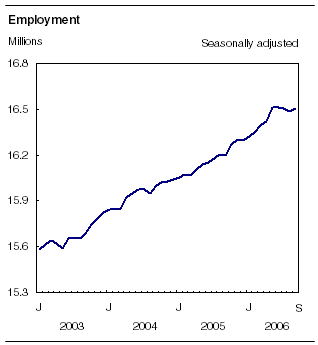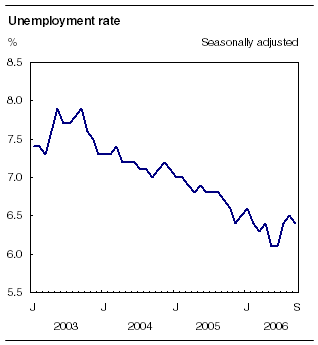Common menu bar links
Labour Force Survey
Archived Content
Information identified as archived is provided for reference, research or recordkeeping purposes. It is not subject to the Government of Canada Web Standards and has not been altered or updated since it was archived. Please "contact us" to request a format other than those available.

Employment edged up slightly in September (+16,000), following three months of little change. The unemployment rate dipped 0.1 percentage points to 6.4% in September, while the share of the population which was employed remained near record highs. Since the beginning of the year, employment has increased by 210,000 (+1.3%).

In September, an increase of 31,000 in part-time was partly offset by a decline of 15,000 in full time. The trend in full-time employment is up, and has accounted for the bulk of the gains over the last three years. So far in 2006, full-time employment has risen by 1.4%, a growth similar to the 1.3% increase in hours worked.
The unemployment rate for adult women fell to 5.0% in September, its lowest level in 30 years.
Average hourly wages increased 3.0% from September 2005, remaining above the most recent year-over-year gain of 2.1% in the Consumer Price Index. Wage growth continues to be strong in Alberta's tight labour market, jumping 7.7% from a year ago.
So far in 2006, Alberta, Saskatchewan, Newfoundland and Labrador as well as British Columbia have experienced employment growth rates above the national average of 1.3%.
Industries with strong year-to-date employment growth include natural resources, business, building and other support services, and health care and social assistance. On the other hand, manufacturing has remained weak.

Record-low unemployment rate for adult women
In September, employment among adult women aged 25 and over rose by 22,000, and their unemployment rate fell 0.4 percentage points to 5.0%, the lowest in 30 years. There was little change in employment among adult men. A substantial increase in the number of adult men looking for work in September pushed their unemployment rate up 0.2 percentage points to 5.5%.
The youth job market declined for the fourth consecutive month in September. During this period, youth employment fell by 42,000, bringing it to the same level as at the start of the year.
So far this year, adult women have experienced most of the gains in employment (+2.5% or +159,000), with increases in finance, insurance, real estate and leasing, health care and social assistance, and retail trade.
In contrast, employment among adult men over the same period has grown by only 0.7% (+51,000), pulled down by losses in wholesale trade, transportation, and manufacturing.
Growth in 2006 is dominated by private sector employees
Most of the employment increase since the start of the year has been among private sector employees (+2.2%). Public sector employment grew more slowly over the same period (+1.0%). In contrast, the number of self-employed fell by 2.2% over the first nine months of 2006 despite an increase in the third quarter.
Service sector drives growth in 2006
Over the first three quarters of this year, the service-producing sector has contributed to the bulk of employment growth, with gains in business, building and other support services (+4.9%), health care and social assistance (+4.7%), and finance, insurance, real estate and leasing (+4.6%). In September, however, none of the industries in this sector showed a significant change.
There were an estimated 19,000 more factory workers in September. However, so far in 2006, the goods-producing sector has experienced weakness, the result of a sharp decline of 3.1% (-67,000) in manufacturing employment, mostly in Central Canada. Although the construction industry continues to employ a large number of workers, growth has ground to a halt compared to the brisk pace of the past three years. On the other hand, natural resources continues to act as a pillar of strength, with an employment growth of 8.0% (+25,000) so far this year. Employment in Alberta's oil patch has been particularly strong.
Robust employment growth in Saskatchewan
Saskatchewan added 7,000 workers to its workforce in September, bringing total gains since the start of the year to 18,000 or 3.7%, a rate of growth second only to Alberta. Increases over the first nine months of 2006 occurred in a number of industries, including agriculture and natural resources.
In September, the proportion of the employed working-age population in Saskatchewan jumped a full percentage point to 66.7%, marking the fourth consecutive month where the employment rate reached a record high. More workers were employed in education and accommodation and food services. The unemployment rate fell by 1.1 percentage points to 4.3%, the lowest since January 1982.
Although employment in Alberta was little changed in September, this province accounted for 80,000 or 37.9% of all workers added in Canada since the start of 2006, by far the strongest performance of any province. Strength has come from a number of industries, notably natural resources, which grew 11.0% over the first nine months of the year. Alberta's strong economy has also fuelled growth in public administration, health care and social assistance, and construction.
In September, a substantial decline in the number of youths participating in Alberta's labour force, along with employment gains among adults, pushed the unemployment rate down 0.7 percentage points to 3.5%. Despite this month's steep decline, the youth labour force participation rate remained healthy at 69.9%.
So far in 2006, employment in Newfoundland and Labrador has increased 3.1% (+7,000). The proportion of the employed working-age population attained a record high in September, as it edged up to 50.9%. Business, building and other support services as well as information, culture and recreation have spurred the employment gains since the start of the year.
British Columbia also posted employment growth above the national average over the first nine months of 2006, with an increase of 1.6% (+34,000). Gains over this period have been in a number of industries, with the largest in business, building and other support services, health care and social assistance, educational services, and natural resources.
So far in 2006, employment in Central Canada has been lacklustre. Employment in Ontario has increased by only 0.8% (+54,000). Employment in manufacturing has been substantially weak, decreasing 4.0% over the first nine months of 2006. However, this has been offset by growth in a number of service industries, notably in health care and social assistance, retail and wholesale trade, and finance, insurance, real estate and leasing. In September, a decline in the number of adult men working (-18,000) pushed the overall unemployment rate in the province up by 0.2 percentage points to 6.6%.
In Quebec, employment growth so far in 2006 has been well below the national average, with only a 0,6% gain (+22,000). Setbacks in manufacturing, public administration and trade have hindered overall employment gains in the province.
Available on CANSIM: tables 282-0001 to 282-0042, 282-0047 to 282-0064 and 282-0069 to 282-0099.
Definitions, data sources and methods: survey number 3701.
Available at 7:00 a.m. online under The Daily module.
A more detailed summary, Labour Force Information (71-001-XIE, free) is now available online for the week ending September 16. From the Publications module of our website, under Free Internet publications, choose Labour. LAN and bulk prices are available on request. The CD-ROM Labour Force Historical Review, 2005 (71F0004XCB, $209) is also available.
Data tables are also now available online. From the By Subject module of our website choose Labour.
The next release of the Labour Force Survey will be on November 3.
For general information or to order data, contact Client Services (toll-free 1-866-873-8788; 613-951-4090; labour@statcan.gc.ca). To enquire about the concepts, methods or data quality of this release, contact Vincent Ferrao (613-951-4750), Danielle Zietsma (613-951-4243) or Jane Lin (613-951-9691), Labour Statistics Division.


 Table(s).
Table(s).